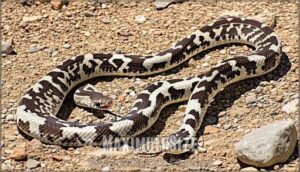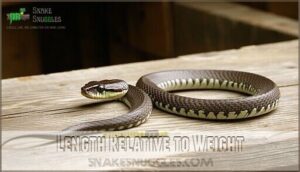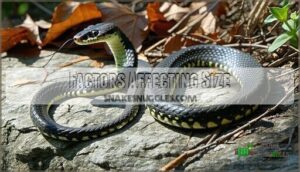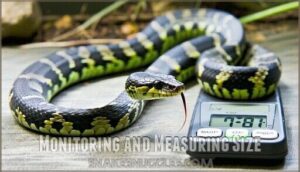This site is supported by our readers. We may earn a commission, at no cost to you, if you purchase through links.
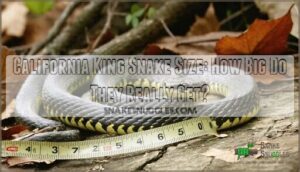 You’ll find that California king snakes typically measure 3 to 4 feet in length when fully grown, though exceptional specimens can reach up to 6 feet.
You’ll find that California king snakes typically measure 3 to 4 feet in length when fully grown, though exceptional specimens can reach up to 6 feet.
Their size parameters, including length and weight, become essential when considering proper housing requirements. Adult California kings usually weigh between 1 to 3 pounds, with females generally growing slightly larger than males.
Their girth varies considerably based on genetics, diet quality, and overall health status. The california king snake size how big do they get question depends on several factors including their specific morph and environmental conditions.
Understanding these size parameters becomes essential when you’re considering proper housing requirements and recognizing whether your snake’s growth follows healthy developmental patterns.
Table Of Contents
- Key Takeaways
- California Kingsnake Size
- How Big Do They Get?
- Size at Maturity
- Maximum Size
- Length Relative to Weight
- Size Differences Between Sexes
- Size Variation Among Morphs
- Factors Affecting Size
- Recognizing Healthy Size
- Monitoring and Measuring Size
- Frequently Asked Questions (FAQs)
- How big are California kingsnakes when they are full grown?
- Are California kingsnakes aggressive?
- What is the lifespan of a California king snake?
- What is the largest California king snake?
- How fast do California kingsnakes grow?
- What is the average clutch size for California kingsnakes?
- Should I be concerned if my California kingsnake stops eating over the winter?
- When do California kingsnakes stop growing completely?
- How much space does my kingsnake need?
- What size prey should I feed adults?
- Conclusion
Key Takeaways
- You’ll find California kingsnakes typically reach 3-4 feet in length when fully grown, though exceptional specimens can stretch up to 6 feet, with females generally growing larger than males.
- Your snake’s final size depends on three key factors: genetics, diet quality (proper prey sizing and feeding frequency), and environmental conditions (adequate space, temperature, and humidity).
- You can expect your adult kingsnake to weigh between 1-3 pounds despite their impressive length, as they maintain naturally lean, streamlined bodies that prioritize length over bulk.
- You’ll need to monitor your snake’s growth through regular measurements and weight tracking, especially during the first two years when they experience rapid development before reaching maturity around 3-4 years old.
California Kingsnake Size
When you’re considering a California kingsnake (Lampropeltis californiae), you’ll find these serpents typically reach 3 to 4 feet in length with a body diameter of 1.2 to 2 inches.
You can expect your adult specimen to weigh between 1 to 3.3 pounds, making them perfectly manageable for handling while still maintaining their impressive constrictor strength.
Length
Most California kingsnakes reach their full snake length potential between 3-4 feet, though some exceptional specimens break size limits by growing over 6 feet long.
Understanding these growth patterns helps you appreciate your snake’s development in its king snake habitat.
- Length records show wild specimens averaging 2.5-3.5 feet
- Female snakes typically outgrow males by several inches
- Genetics determine maximum growth potential for each individual
- Scale variations don’t affect overall snake growth measurements
- Measurement tips include using flexible tape along the spine
Girth
While snake length gets most attention, girth measurement tells the complete size story.
California king snake body width typically ranges from 1.2 to 2 inches across their thickest cross section. Well-fed adults develop proportional snake diameter that matches their overall scale texture and health.
| Age Group | Girth Range |
|---|---|
| Hatchlings | 0.5-0.75 inches |
| Juveniles | 0.75-1.25 inches |
| Adults | 1.2-2.0 inches |
| Large Adults | 1.8-2.2 inches |
Your snake’s girth reflects nutrition quality and genetics more than king snake size alone.
How Big Do They Get?
The question of maximum dimensions sparks curiosity among snake enthusiasts. Your California king snake will typically reach 2 to 4 feet in length, though exceptional specimens can stretch up to 7 feet.
Most wild individuals hover around 2.5 to 3.5 feet, making them perfectly manageable companions. These snakes showcase fascinating growth patterns that vary by location and genetics.
The largest documented California king snake measured an impressive 78 inches on Mexico’s Isla Ángel de la Guarda. However, don’t expect your pet to reach these extreme size limits.
While your pet kingsnake won’t reach record-breaking lengths, it’ll still surprise you with impressive growth potential beyond typical expectations.
Key size characteristics include:
- Body proportions remain slender throughout their lifespan
- Scale variation doesn’t substantially affect overall length
- Morph development can influence final dimensions
- Maximum size depends on genetic lineage
- Growth patterns slow considerably after reaching maturity
Understanding these factors helps you provide appropriate housing and care for your snake’s natural size potential.
Size at Maturity
Around their third or fourth birthday, these serpents hit their stride and reach what we call size maturity. Most males clock in at 2-3 feet when they’ve reached their adult dimensions, while females typically stretch a bit longer at 2.5-4 feet.
Think of it like hitting your growth spurt – the rapid changes slow down, but they don’t completely stop growing. Your california king snake will continue adding length gradually throughout its 20+ year lifespan, though the dramatic growth patterns of youth give way to slower, steadier increases.
Here’s what influences their mature weight and final size limits:
- Genetic inheritance from parent snakes
- Incubation temperature during egg development
- Feeding frequency and prey quality
- Available habitat space for exercise
- Overall activity levels and movement patterns
Monitor your snake’s progression toward these maturity length milestones. With proper care, most reach their full genetic potential by age 5-6, establishing their permanent adult king snake size range.
Maximum Size
While most California King Snakes reach maturity around 3-4 feet, their record length tells a different story entirely.
These impressive serpents can achieve maximum size well beyond what you’d expect, with documented specimens exceeding 6 feet in length.
The largest recorded California King Snake stretched an astounding 6.8 feet, showcasing the species’ true growth patterns potential.
Your snake’s size limits depend heavily on genetics and environmental conditions.
Wild populations often display greater maximum girth and overall dimensions compared to captive specimens.
Scale size remains proportional regardless of length, maintaining the snake’s distinctive appearance even in giants.
Most captive California King Snakes plateau around 4-5 feet due to space constraints, but exceptional individuals with favorable genetics can surprise you.
Snake size variations within the species are remarkable, proving that these constrictors possess far greater size potential than their average measurements suggest, with record length and maximum size being key factors.
Length Relative to Weight
Slender builds define these remarkable serpents, creating fascinating size ratios that surprise many keepers. You’ll notice California kingsnakes prioritize length over bulk, typically weighing just 1-3 pounds despite reaching 3-4 feet long.
These lean constrictors pack impressive strength into surprisingly lightweight bodies, defying expectations with their deceptive power-to-weight ratio.
Their body proportions reflect an evolutionary advantage – streamlined forms help them navigate tight spaces while hunting. Weight factors include genetics, feeding frequency, and overall health status.
A 4-foot adult might weigh only 2 pounds, showcasing their naturally lean physique. Length variations don’t always correlate with weight gain, as some specimens grow longer while maintaining consistent girth measurements.
Growth patterns reveal these snakes add inches more readily than ounces. You can expect your snake’s weight to increase gradually while length develops more dramatically. This unique relationship between size dimensions helps distinguish healthy specimens from those requiring dietary adjustments or veterinary attention.
Understanding the python body length vs weight correlation is essential for evaluating the overall health of snakes, including factors like python size differences. This knowledge is crucial for evaluating overall health and making informed decisions about snake care, particularly in terms of dietary adjustments and veterinary attention.
Size Differences Between Sexes
When comparing California king snakes, you’ll notice interesting Size Dimorphism between the sexes.
Female Length typically exceeds male dimensions, with adult females growing noticeably larger than their male counterparts.
This Sexual Dimorphism affects overall king snake size, as Male Growth patterns differ from female development.
Males compensate with longer, thicker tails used for gripping during breeding.
These Gender Proportions reflect biological adaptations rather than environmental factors.
Growth Patterns show females reaching greater Maximum Size, while males mature with more compact builds, creating distinct Sex Size Comparison characteristics within the species.
Size Variation Among Morphs
Different California King Snake morphs don’t just vary in appearance—they show distinct size differences too.
You’ll notice striped morphs typically reach the largest dimensions, averaging 4-5 feet at maturity.
Albino and lavender varieties tend to max out smaller, usually hitting 3-4 feet.
These morph differences stem from size genetics that influence individual growth rates.
Here’s what affects morph-specific sizing:
- Color variance genes may redirect energy from growth into specialized pigment production
- Morph patterns correlate with different metabolic rates during development
- Growth rates vary between morphs due to underlying genetic variations
When you’re selecting a California King Snake, remember that genetics set the foundation for potential size, but ideal care helps any morph reach its maximum length.
Regular measurements let you track whether your snake’s achieving typical size benchmarks for its specific morph pattern.
Factors Affecting Size
Your California kingsnake’s final size isn’t just a roll of the genetic dice—it’s shaped by three key factors that work together throughout its lifetime.
Understanding how genetics, environmental conditions, and dietary habits influence growth patterns will help you predict your snake’s adult dimensions and provide ideal care for healthy development.
Genetics
Like a blueprint determining a building’s height, genetic variation sets the foundation for your California kingsnake’s maximum size potential.
Heredity factors from both parents create unique inherited traits that influence growth rate and final dimensions.
Key genetic influences on king snake size include:
- Morph inheritance – Different color morphs carry size-determining genes
- Gene expression – How actively growth genes function throughout development
- Chromosomal factors – The 36-chromosome structure affecting overall growth patterns
Understanding king snake genetic traits is essential for breeders and owners alike.
Environment
Environmental factors substantially influence your California King Snake’s growth potential and final size.
- Habitat Space: Cramped enclosures restrict natural movement and growth patterns
- Temperature Control: Consistent 80-84°F promotes healthy metabolism and development
- Humidity Levels: Proper 35-60% humidity supports skin shedding and hydration
- Enclosure Size: Adequate space allows natural behaviors that encourage growth
- Lighting Conditions: Natural day/night cycles regulate feeding and activity patterns
Properly designed snake enclosure systems are vital for simulating natural environments.
Diet
Your California king snake’s diet directly impacts its growth potential and final size.
Proper prey selection involves offering rodents that match 10-15% of your snake’s body weight every 7-10 days for juveniles. Adult snake feeding requires weekly meals sized to match the snake’s thickest point.
Consistent food intake supports healthy digestion process and meets essential nutrient needs, while overfeeding can stunt natural development patterns.
Understanding the snake’s king snake diet requirements is vital for healthy growth and health.
Recognizing Healthy Size
Three key health signs reveal whether your California king snake size falls within normal parameters.
First, examine your snake’s body condition by gently feeling for appropriate muscle tone without excess fat deposits around the spine or tail base.
A healthy adult should measure 3-5 feet with proportional girth that’s neither too thin nor overly thick.
Second, assess scale condition – healthy snakes display smooth, glossy scales without dullness or retained shed pieces.
Third, monitor growth patterns by tracking length and weight monthly during the first two years.
Weight management becomes essential as overfeeding creates health issues while underfeeding stunts development.
Active feeding responses, regular movement, and consistent shedding cycles indicate proper size indicators.
These factors affecting size help distinguish normal snake size variation from concerning health problems requiring veterinary attention.
The key health signs include examining the snake’s body condition, assessing scale condition, and monitoring growth patterns.
Weight management is crucial to prevent health issues.
Regular monitoring and maintenance of these health signs can ensure your snake remains healthy and thrives.
By tracking these signs, you can identify any potential health problems early on and seek professional help if necessary.
Monitoring and Measuring Size
Tracking your California King Snake’s development requires consistent monitoring using proper measurement tools and techniques.
Regular size tracking helps you understand your snake’s growth rates and guarantees healthy development through various development stages.
Here’s your essential monitoring toolkit:
- Length measurement: Use a flexible measuring tape along the snake’s body from nose to tail tip, recording measurements monthly
- Weight tracking: Employ a digital kitchen scale for accurate weight documentation, weighing your snake every two weeks
- Scale patterns documentation: Photograph your snake’s markings to monitor any changes in coloration or pattern clarity over time
Compare your snake size variation data against established California King Snake maximum size charts.
Normal growth rates vary substantially between individuals due to genetics, diet, and environmental factors.
If you notice sudden changes in king snake size progression, consult a reptile veterinarian for guidance.
Understanding snake growth patterns is vital for identifying potential issues in your snake’s development.
Frequently Asked Questions (FAQs)
How big are California kingsnakes when they are full grown?
You’ll find that adult California kingsnakes typically reach 3-4 feet in length, though some exceptional specimens can grow up to 6 feet.
They’re perfectly sized for handling—not too intimidating, yet impressive enough to captivate.
Are California kingsnakes aggressive?
You’ll find these snakes aren’t aggressive by nature.
They’re actually quite docile compared to similar-sized species, only becoming defensive when threatened or provoked.
Their calm temperament makes them excellent pets for beginners.
What is the lifespan of a California king snake?
In captivity, you’ll find your California kingsnake typically lives 15-20 years with proper care.
Wild specimens face more challenges, averaging 10-15 years.
Good husbandry, nutrition, and veterinary care maximize their lifespan potential.
What is the largest California king snake?
You’ll find the largest California king snake on record reached an impressive 78 inches (about 5 feet) on Isla Ángel de la Guarda in Mexico.
Though most adults typically max out around 3-4 feet in length, this is a notable exception, and the largest size is an interesting fact.
How fast do California kingsnakes grow?
Juvenile growth spurts, adult growth plateaus, captive conditions accelerate development. You’ll see rapid growth in year one, reaching 12-18 inches. They’ll hit full size within three to four years.
What is the average clutch size for California kingsnakes?
California kingsnakes typically lay 3-12 eggs per clutch, with most females producing 5-8 eggs. You’ll notice larger, well-fed females often have bigger clutches, while younger snakes produce fewer eggs annually.
Should I be concerned if my California kingsnake stops eating over the winter?
Most kingsnakes naturally reduce feeding during winter months through brumation behavior.
Don’t panic—this seasonal appetite decrease is completely normal.
Monitor your snake’s weight and guarantee proper temperatures, but temporary fasting won’t harm healthy adults, as this is a normal part of their behavior.
When do California kingsnakes stop growing completely?
Growth continues throughout your snake’s entire lifespan, though it dramatically slows after reaching sexual maturity around 2-4 years old.
They’ll keep adding length gradually, but you won’t notice significant changes annually.
How much space does my kingsnake need?
Adult kingsnakes need at least a 40-gallon terrarium, though bigger‘s always better.
Hatchlings start in 10-gallon setups, while juveniles thrive in 20-gallon tanks.
You’ll upgrade enclosures as your snake grows throughout its lifetime.
What size prey should I feed adults?
Adult California kingsnakes should receive prey items roughly equal to their thickest body section – typically adult mice or small rats.
You’ll want prey that’s about 1-2 inches in diameter for proper digestion.
Conclusion
Ironically, understanding California king snake size how big do they get becomes simpler once you’ve grasped the complexity of variables involved.
You’ll find these serpents typically reach 3-4 feet, with genetics, diet, and environment playing vital roles in their development.
Monitoring your snake’s growth against established parameters helps guarantee healthy development patterns.
Remember, proper housing accommodations must match their adult dimensions, and regular measurements help track normal progression versus potential health concerns requiring veterinary attention.


